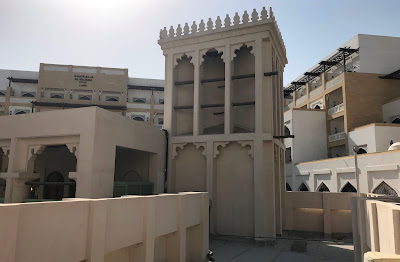During the last few decades, Doha has emerged as one of the world's most modern cities. One can see most modern and beautiful buildings rising all over the city. Until 1950s Doha was a sleepy coastal town. But even then it had many beautiful palaces, houses of merchants and other official buildings. Many of them have not survived due to rapid development, but still, you can find some examples of beautiful traditional architecture of Qatar.
One such example of old traditional architecture is an old house right in the heart of Doha city, in an area once known as Barahat Al Jufairy, now a part of larger Souq area of the city. It is just a hundred metres away from the world famous Souq Waqif and is located in Souq Najada at 25°17'7.73"N; 51°31'59.88"E.
The Majlis of Barahat Al Jufairy. (26.01.2019.)
The most prominent feature of this old house is its Malqaf or Badgir, the wind tower. (26.01.2019.)
Currently, the house is surrounded by modern buildings. (26.01.2019.)
A view from the east. (26.01.2019.)
The northeastern corner of the house. (26.01.2019.)
The northern and the eastern walls. (26.01.2019.)
The western wall of the house. (26.01.2019.)
Stone benches were a popular feature of the old houses. (26.01.2019.)
The southwestern corner of the house, and the wind tower. (26.01.2019.)
According to a book العمارة التقليدية في قطر (Traditional Architecture in Qatar), written by Mr Mohammad Jassim Al Kholaifi the house was built sometime during the first quarter of the 14th century AH. That means it was built between 1882 - 1907 AD. So it is well over a century old. It remained in the possession of several owners, including Mr Ahmad Bin Mohammad Al Emadi, who in turn sold it to Mr Mohammad Bin Zain Al Abideen for 2,000 Indian Rupees. The sale agreement is dated 20.03.1341. AH. i.e. 10.11.1922.
In 1978 the government of Qatar bought it and in 1982-83 it was repaired and restored. It was formally opened as an Ethnographic Museum, on 22 February, 1985, showcasing some aspects of life in Qatar before the discovery of oil.
A beautiful date palm tree in the courtyard. (26.01.2019.)
The south side has an Iwan, verandah in front of rooms on both the first and the second floor of the house. (26.01.2019.)
One of the three staircases leading to the first floor. (26.01.2019.)
One of the 13 rooms in the house. (26.01.2019.)
The above two pictures show the wind tower from the first floor. (26.01.2019.)
A room right below the winder tower. (26.01.2019.)
A beautifully decorated room with the pictures of HH the Amir of Qatar Sheikh Tamim Bin Hamad Al Thani and HH the Father Amir Sheikh Hamad Bin Khalifa Al Thani. (26.01.2019.)
The above two paintings show glimpses of life in the past. (26.01.2019.)
The above four pictures are of the room on the first floor. (26.01.2019.)
The view of the date palm tree from the first floor. (26.01.2019.)
A view of the courtyard from the above. (26.01.2019.)
The first floor has only two rooms. This is the smaller one. (26.01.2019.)
A staircase beside the entrance. (26.01.2019.)
A view of the house from the east. (02.02.2019.)
The majlis, drawing room, has big windows for the fresh air and light. (02.02.2019.)
A room furnished with traditional mattresses for sitting. (02.02.2019.)
The above three pictures show the bottom of the wind tower from inside. (02.02.2019.)
The house had its own well for the fresh drinking water, a precious commodity in this desert region. (02.02.2019.)
Mr Ali Obaidan, sitting in the majlis. (02.02.2019.)
On my second visit to the house, I had a chance to meet Mr Ali Obaidan. He is an engineer by profession and a retiree of Qatar Petroleum. Many families of his relatives lived in this area and he is very fond of this place. He is a regular visitors to this majlis. He informed me that once this building housed an ethnographic museum. But it was felt that the location is not suitable for a museum, hence after some deliberation, it was decided to convert this place into a meeting place for the general public. He also informed me that HH the Father Emir Sheikh Hamad Bin Jassim Al Thani took a special interest in making this decision.
Currently, the government takes full responsibility for its upkeep and maintenance. Mr Ali informed me that old residents of this locality still come to meet their friends and share their sweet memories. They come here to relax and meet their friends in a soothing atmosphere. It is a great place to sit together and discuss subjects of common interest. The management serves tea to all the vistors free.
It was a common practice to put big wooden chairs for the convenience of the passersby to take rest. And to sit and chat with the neighbours. (02.02.2019.)
An aerial photograph taken in 1959, showing the location of the Majlis. (Taken from the website: http://originsofdoha.org/doha/)
A plan of the house. (Taken from the book: The History of Qatari Architecture)
An old traditional cafe in the same locality. (16.01.2019.)
So next time when you go to Souq Waqif don't forget to visit this wonderful place. I am sure you will enjoy it, especially if you are interested in knowing the past of this country and its cultural heritage.
Tariq Amir
February 3, 2019.
Doha - Qatar.







































No comments:
Post a Comment